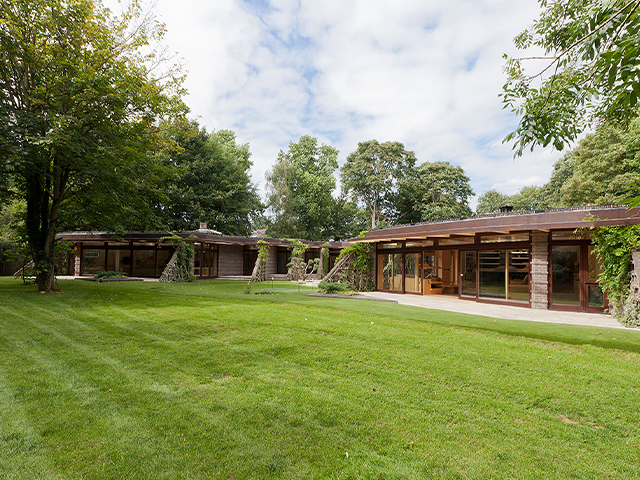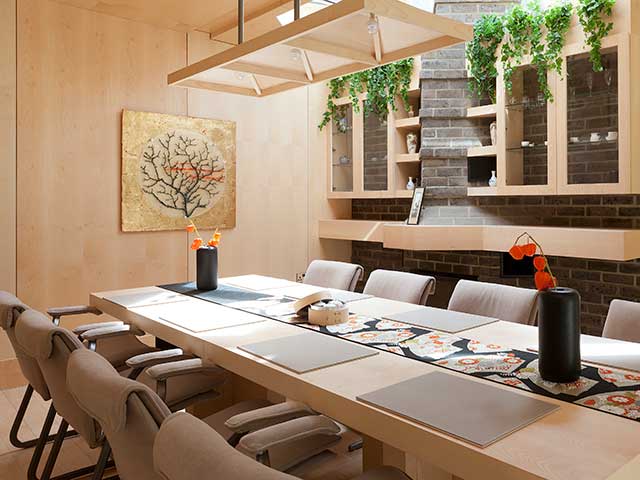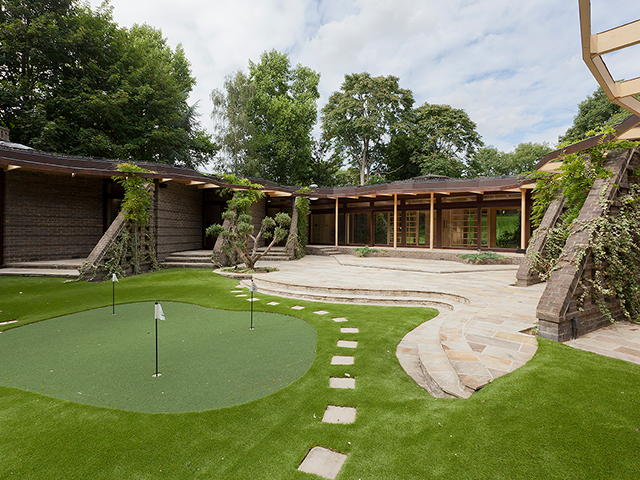The Hertfordshire home built on a historically significant site
Building this unique new home on protected land was no mean feat
Abbey Orchard House, located about half an hour away from St Albans, was built on protected land close to one of Britain’s oldest abbeys. So it was imperative that this Grand Designs home in Hertfordshire paid respect to the history that underpins its foundations.
Golf ought not to come into it, but the sport significantly influenced the design. ‘I’ve known Rogan Gale-Brown for more than 20 years,’ says entrepreneur Chris, whose golf interests encompass all aspects of the game, from coaching to course design. ‘We’ve worked together on the design of golf club complexes and he has also previously been involved in creating homes for me.’
Designer Rogan says that this connection with Chris and his wife, Kayo, goes deeper than a typical client relationship: ‘I’d become infused with their way of life before starting the design. Chris met Kayo, who represented Japan at figure skating, when she came to him for golf lessons.
The couple have three teenagers and because the design evolved, it took into account the youngsters’ growing need for independence. Each of them has a self-contained bedroom, with a terrace and ‘space for contemplation’, as Rogan puts it. This is much more than a passing reference to adolescent need for privacy. The cell-like design of these bedrooms goes straight to the heart of the site and its history.

The planting reflects the history of the site and formal Japanese gardens. Photo: Fiona Walker-Arnott
A historic plot
This plot, between a historic cathedral and a picturesque river, is a Scheduled Ancient Monuments Site, and it covers the buried remains of a medieval monastery precinct. It is almost inconceivable that permission to build a house on it would be achieved at all. Yet this building manages to pay respect to all the history that underpins its foundations, and at the same time is a welcoming family home.
For more than three decades, various people had tried to build on the site, with no success. Sadly, this area had become a strip of vandalised wasteland between the river and Chris and Kayo’s existing house, which is being sold to finance their new home. It took the couple six years of steely determination, compromise and endless alterations to convince English Heritage and the local council that this new house would work. ‘When I want to do something, I don’t like to back down,’ says Chris. ‘So I was determined to sort this out.’

The maple furniture was produced in Slovakia. Photo: Fiona Walker-Arnott
Unusual layout
The unusual shape of the house echoes a zig-zagging ‘H’ in order to respect the surroundings and underlying artefacts. It follows the gentle contours of the sloping site. The property is single storey to preserve sight lines to and from the cathedral.
It’s constructed from light timber cassettes to prevent disturbing the medieval treasures beneath. Distinctive cinder-coloured narrow bricks clad the building, in a style that connects it to the Romans who left their traces on the area.

Handleless cupboards and wraparound worktops create a streamlined look. Photo: Fiona Walker-Arnott
This brickwork is softened with a mass of planting to create colour and an organic link between the man-made structure and nature. This can be seen in the green and gold of Hedera Golden Ripple ivy. You can also see it in the soft blue Japanese Wisteria Chinensis, which evokes a connection with Kayo’s homeland.
The glazed link between the two wings – broadly, the sleeping area and the living area – gives the impression of invisibility, which pleased the planners. The flat and bio-diverse sedum-covered roof with three roof lights and light tubes provides additional thermal and sound insulation.

The dining room includes a maple table and a custom-made light fitting. Photo: Fiona Walker-Arnott
Japanese-inspired design
‘The design was inspired by the layouts of winged country villas. Including the formal simplicity of Japanese traditional houses, medieval monastic design, and elements that include ivy-covered ruined walls, fallen logs with moss, and cantilevered mushroom growths,’ explains Rogan.
All the fitments and furniture were custom-designed by Rogan to accord with these principles. Only certain dining chairs, the bedroom sofas, and kitchen unit infills and peninsula unit were chosen by Chris and Kayo.
The overall effect is simple, streamlined and clean. The walls and cabinets, also in maple, provide a seamless backdrop for Kayo’s collection of heirloom kimonos and Chris’ golfing memorabilia. Kayo takes great pride in running a well-organised home and was keen to ensure cupboards in the kitchen fulfilled her requirements.

The wood-burning stove is complemented by an exposed brick fireplace. Photo: Fiona Walker-Arnott
A family home
Rogan says every element of the home reflects the family’s functional, emotional, and spiritual needs. It’s his personal philosophy, but often attributed to the mid-century architects who pioneered this all-encompassing approach. ‘Kayo and I are fond of great architects such as Frank Lloyd Wright and wanted to follow classical design influences,’ says Chris.
There’s no doubting the ambition of both homeowners and the designer. The sheer attention to detail added around two years onto the initial time frame, and Chris ended up running the build when the original project manager departed. ‘I wouldn’t say I project-managed,’ he says. ‘I just oversaw the team and did bits and pieces.’
No-one could question the onerous demands placed on this project by planning and conservation stipulations. Neither could they fail to respect the dedication to deliver a project so exacting to the site and strict visual principles. However, this is still a family home, and in it, there is plenty of space for relaxation and fun. There is a putting green in the garden.
Meanwhile, in the kitchen, Rogan persuaded Kayo to cover her collection of cookery books with a selection of delicately patterned traditional Japanese rice papers called ‘washi’. ‘I have no idea which is which now,’ jokes Chris. ‘He never uses them anyway,’ replies his wife. Collaboration can only go so far, it seems.

In the garden, a putting green allows for golf practice. Photo: Fiona Walker-Arnott









